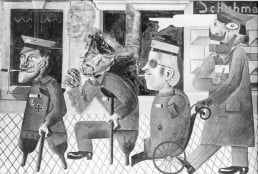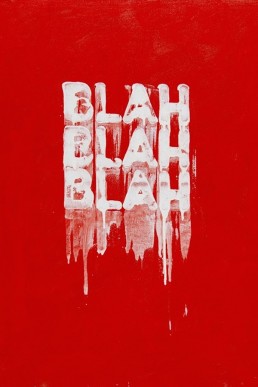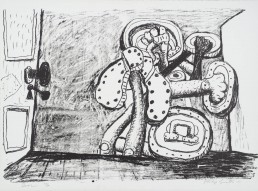What’s So Funny?
By Peter Birch
Usually, you don’t combine the words humour and art. It’s like they are almost conflicting notions. They both serve as entertainment, but whereas humour is known for being silly, foolish and even sometimes stupid, art should be enjoyed with the greatest of respect. Almost with a serious and religious devotion. Here is nothing to laugh about, so please hide your nervous giggling at the gallery, if you are afraid of missing the point. Or is it in fact okay to have a laugh when interacting with a piece of art?
What if we turn this conventional understanding of art and humour upside down? What if they coexist brilliantly together? Maybe, in fact, the language of humour can be a helping hand in a strict and conformal world of art. Let’s give it a try.

Instead of being contradictory, art can be the perfect platform for funny ideas, and the other way around. Hidden as a funny motif, an artist can use the ropes of humour to convey a scathing message about social or political circumstances. That is how humour is used in especially contemporary art. Loaded with thick ironies, surrealistic motifs and strict expressions of horror and grief, the message can be sarcastic and satiric. A message so harsh and even grotesque, that you don’t know if you are about to laugh or cry. We know the expressionistic and ironic works form artists like Weimar’s Georg Grosz and Otto Dix who made sarcastic comments on the German society between the world wars. Nowadays artists like Danish Michael Kvium presented his thought-provoking Circus Europe (2017) exhibition at Arken Museum of Modern Art in Ishøj, Denmark, as a comment on the present political situation of Europe. Welcome to the carousel!

But what if the joke is on the art world itself? Contemporary artist Mel Bochner is recognized as one of the leading figures in the development of conceptual art in New York in the 1960’s and 1970’s. Fed up with the trend of the times, Bochner along with other newcomers sought new fields with their conceptual art. His work Blah Blah Blah (2015) is a red canvas bearing the ambiguous message in white letters. What is his point? Is there any point at all? This imaginary ambivalence confuses the audience, as you in the end remember that the words are meaningless. Is this a message about art, or is it merely playing trick on us?

Another example is Philip Gustons Door (1980). Funny in a different and maybe more innocent way. As the title indicates, the lithography contains a door, but the rest of the jumble is hard to figure out. Are we supposed to look at the door? Is there any point? Or are we actually just allowed to smile and have a laugh of this clumsy scenario. Either way Gaston is teasing us, probably with a luminous smile.
Clearly, the service of humour can be used in vast different ways. Sometimes there is a message, sometimes there isn’t. No matter what, humour definitely has a sound reason to be present in the art world. No matter if there is a deeper laying message or if the artist just wants to tease you a bit. Anyway, feel free to be entertained in a humorous way. At the end of the day, it’s up to what you want to get out of it, laughing or not!

About Peter Birch
Driven by a curious mind, 27-year-old historian Peter Birch is constantly looking for new adventures in his city Copenhagen. As an avid explorer, he seeks out every nook and cranny in the world of art. He is no expert in the field, but he is an expert in asking questions and challenging the predominant opinions. Follow in Peter’s footsteps and discover the art world through new eyes.
Get your free copy of Artland Magazine
More than 60 pages interviews with insightful collectors.